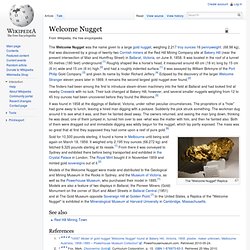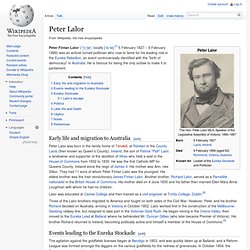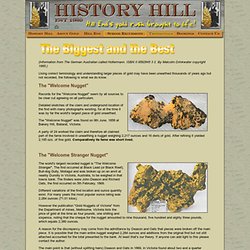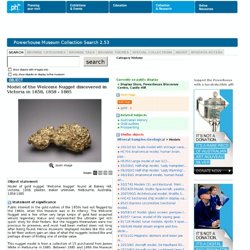

Australian Gold Rush. Eureka Rebellion. Welcome Nugget. The Welcome Nugget was the name given to a large gold nugget, weighing 2,217 troy ounces 16 pennyweight. (68.98 kg), that was discovered by a group of twenty-two Cornish miners at the Red Hill Mining Company site at Bakery Hill (near the present intersection of Mair and Humffray Street) in Ballarat, Victoria, on June 9, 1858.

It was located in the roof of a tunnel 55 metres (180 feet) underground.[1] Roughly shaped like a horse's head, it measured around 49 cm (18 in) long by 15 cm (6 in) wide and 15 cm (6 in) high,[2] and had a roughly indented surface.[1] It was assayed by William Birkmyre of the Port Philip Gold Company [3] and given its name by finder Richard Jeffery.[4] Eclipsed by the discovery of the larger Welcome Stranger eleven years later in 1869, it remains the second largest gold nugget ever found.[2] The finders had been among the first to introduce steam-driven machinery into the field at Ballarat and had looked first at nearby Creswick with no luck. See also References. Peter Lalor. Peter Fintan Lalor (/ˈlɔːlər/, locally [ˈloːlə];[1] 5 February 1827 – 9 February 1889) was an activist turned politician who rose to fame for his leading role in the Eureka Rebellion, an event controversially identified with the "birth of democracy" in Australia.

He is famous for being the only outlaw to make it to parliament. Early life and migration to Australia[edit] Peter Lalor was born in the family home of Tenakill, at Raheen in the County Laois (then known as Queen's County), Ireland, the son of Patrick "Patt" Lalor, a landowner and supporter of the abolition of tithes who held a seat in the House of Commons from 1832 to 1835. He was the first Catholic MP for Queens County, Ireland since the reign of James II. His mother was Ann, née Dillon. Lalor was educated at Carlow College and then trained as a civil engineer at Trinity College, Dublin.[2] Events leading to the Eureka Stockade[edit] On 29 November a meeting of about 12,000 men was held at Ballarat.
Eureka Stockade[edit] W. Gold Rush. The Gold Rush-Australian. Eureka Rebellion. Gold - The Biggest & The Best. (Information from The German Australian called Holtermann.

ISBN 0 9592845 3 2. By Malcolm Drinkwater copyright 1985.) Using correct terminology and understanding larger pieces of gold may have been unearthed thousands of years ago but not recorded, the following is what we do know. The "Welcome Nugget" Records for the "Welcome Nugget" seem by all sources to be clear cut agreeing on all particulars. 10097 Model of gold nugget 'Welcome Nugget' found at Bakery Hill, Victoria, 1858, plaster, maker unknown, Melbourne, Australia, 1858-1885 - Powerhouse Museum Collection. Public interest in the gold rushes of the 1850s had not flagged by the 1880s, when this Museum was in its infancy.

The Welcome Nugget and a few other very large lumps of gold had acquired almost legendary status and represented the ultimate 'get rich quick' story for their finders. But the nuggets themselves were too precious to preserve, and most had been melted down not long after being found. Hence museums displayed models like this one to let their visitors gain an idea of what the nuggets looked like and perhaps dream of finding one of similar value.
This nugget model is from a collection of 15 purchased from James White in Melbourne in 1885. Between 1885 and 1886 the Museum also commissioned a local model maker, Mrs AG Goodman, to make copies of New South Wales nuggets as well as commercial fruits and minerals. 'The 'Welcome Nugget' was found on 15th June, 1858 by a party of twenty-two Cornish miners at the Redhill Mining company's claim Bakery Hill, Ballarat. Gold nugget 1851. GoldRush. Australian gold rushes. An Australian gold diggings circa 1855 After the California gold rush began in 1848, causing many people to leave Australia for California to look for gold there, the New South Wales government rethought its position, and sought approval from the Colonial Office in England to allow the exploitation of the mineral resources and also offered rewards for the finding of payable gold.[2] The first gold rush in Australia began in May 1851 after prospector Edward Hargraves claimed to have discovered payable gold near Bathurst, at a site he called Ophir.[3] Hargraves had been to the Californian goldfields and had learned new gold prospecting techniques such as panning and cradling.
